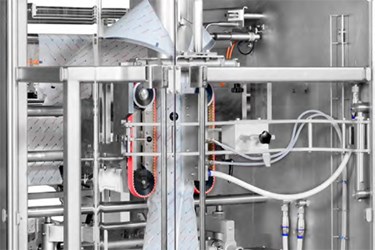Vertical Form Fill Seal Bag Machines: Ironing Out The Wrinkles Of Implementation
By Isaac Fletcher, contributing writer, Food Online

To ensure a smooth and streamlined process when installing a VFFS machine, customers should open lines of communication with vendors to address key areas and engineer machine design to fit specific needs.
Purchasing a vertical form fill seal (VVFS) bag machine can be a lengthy and complicated process. Specifications need to be accurately detailed, prices need to be quoted, the system needs to be built, and then it needs to be delivered. By improving lines of communication between vendor and customer early on in the design stages, the process can be simplified, making for a quicker and smoother experience for all involved parties.
During the design process, one of the key components is the integration of the VFFS machine to an auger filler. For maximum operational efficiency, these two pieces of machinery have to be in sync with each other. For the easiest and smoothest integration, the vendor and the customer need to open communication lines regarding some key considerations:
- What is the product being filled?
- What are the product’s density and flow characteristics?
- What is the bag size and style?
- What is the desired fill rate?
- What is the target weight of the product?
- What are the specifications of the forming tube?
Discussion between the involved parties during the early stages of design can help vendors determine the size and scope of the project, as well as allow the auger filler supplier to determine how achievable the customer’s performance specifications are.
The specifications of the forming tube are critical to designing a system that can be integrated with a VFFS machine. Product-filling speed largely depends on the diameter of the auger, which is determined by the shape of the forming tube. The larger the forming tube, the more product that can be released during an auger revolution. Using an auger with a 2.5 inch diameter will yield 12.27 cubic inches of product in a revolution, but using an auger just a half inch larger in diameter will yield 24.74 cubic inches per revolution.
Knowing the size of the forming tube allows the filling machine’s vendor to know how much space they have to work with inside that tube. If the supplier has this information from the start, they can determine how well they will be able to meet the customer’s specific needs. If certain aspects cannot be met, then the supplier has the time and ability to make necessary adjustments.
The flow characteristics of the products are also very important considerations when looking into a new VFFS machine. Products typically fall into two categories — free flow and non-free flow — each of which requires a unique tooling setup. Accommodating the flow properties of different products may require various tooling setups, including a clam shell cut off, a cone cut off, or a vacuum cut off. Each type of tooling setup requires additional space inside the form tube, which reduces size of the auger and, accordingly, reduces output speed. Vendors and customers should also discuss any electrical specifications that must be met, and the filler supplier needs to know this information upfront when providing a quote for the project.
Lastly, vendors and customers should talk about the factory acceptance tests during the quoting process. What are the criteria for the tests? Will tests take place at the filler company, the bagger company, or both? Additionally, terms should be finalized regarding the installation and training at the customer’s plant.
Although there are many factors to consider and decisions to make, ironing out the details early on by bringing all parties together will help to ensure that performance goals are adequately achieved. Discussions that take place early on will also streamline the integration between form fill seal bag machine and filling machine.
